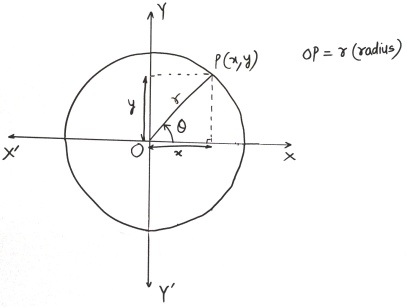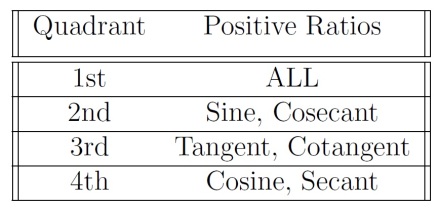-
Prerequisite : Angle and Its Measurement
-
Trigonometric Functions
The trigonometric functions are functions of angles. In the blogpost ‘Angle and Its Measurement‘, we studied what an angle is and how it is measured. An important concept to be recalled is that of coterminal angles. These are the angles, whose initial and terminal rays are identical and their magnitudes differ by an integral multiple of or
.
There are 6 basic trigonometric functions:
1) Sine (abbr. sin)
2) Cosine (abbr. cos)
3) Tangent (abbr. tan)
4) Cosecant (abbr. cosec)
5) Secant (abbr. sec)
6) Cotangent (abbr. cot)
-
Definitions
Consider a circle (radius ) and a point
on it. Fix the
and
axes such that the origin is the center of the circle. Let
be the angle made by
with positive
axis.

Recall: Length of perpendicular from a point on (
) axis gives the magnitude of
(
) coordinate of the point.
Let coordinates of be
and
. Then,
As the location of point changes (along the circle),
changes and so the ratios. Coterminal angles have same trigonometric ratios.
It may also be noted that the ratios are independent of radius of circle.
-
Alternative Definitions
-
Important Identities
For any angle ,
These can be derived from the Pythagoras’ theorem.
-
Domains and Ranges of Trigonometric Functions
1) Function: Domain
and Range
2) Function: Domain
and Range
3) Function: Domain
and Range
4) Function: Domain
and Range $\mathbb R$
5) Function: Domain
and Range
6) Function: Domain
and Range
-
Standard Angles
The angles are termed as the standard angles. Given below are their
and
values. The other ratios can be found using these (if they are defined).

-
Signs of Trigonometric Ratios in the Quadrants
Note: is always positive,
is positive in
and
quadrants,
is positive in
and
quadrants.

-
Periodicity
A characteristic of trigonometric functions is their periodicity. The values get repeated after a certain fixed interval. This can also be seen from the graphs.
A function is said to be periodic, if
in its domain,
, where
is the period.
The least positive value of is known as the fundamental period.
Sine, Cosine, Cosecant and Secant are periodic with fundamental period .
Tangent and Cotangent are periodic with fundamental period .
-
Odd and Even Trigonometric Functions
A function is said to be odd, when
in its domain,
Sine, Tangent, Cosecant, Cotangent are odd functions.
A function is said to be even, when
in its domain,
Cosine and Secant are even functions.